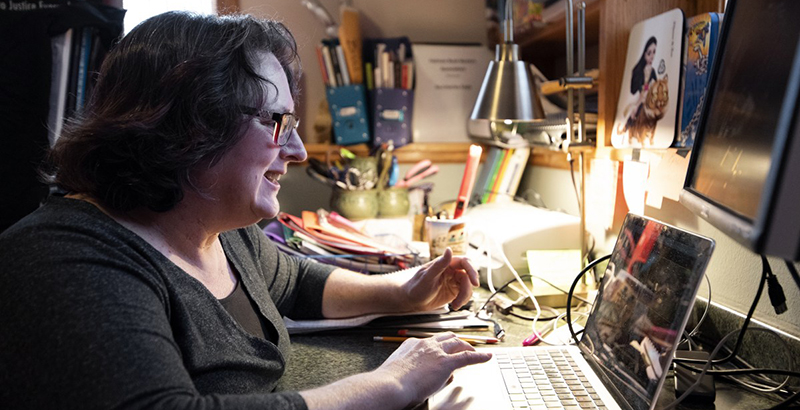‘It Isn’t as Remote and Lonely as I Thought it Would Be’: How One Wisconsin Teacher Is Finding New Ways to Connect With Students Virtually During the Pandemic

This story was produced by Wisconsin Watch, a nonprofit, nonpartisan investigative reporting organization that focuses on government integrity and quality of life issues in Wisconsin. Outbreak Wisconsin chronicles people’s journeys through the coronavirus crisis, exposes failing systems and explores solutions.
Julie Welch starts each school day by heading down the stairs to her basement. Last summer, she turned her guest room into a classroom for the La Crosse School District’s Coulee Region Virtual Academy, an online charter school created as an alternative to in-person classes this year.
Welch checks email and opens the day’s online lessons for her 6th grade class before starting their morning meeting on Zoom.
“Just like if we were in person when kids arrive, we start the day in a circle, greeting each other and just kind of doing that check in, like ‘Hey, how are you doing? What’s new? What do you have to share?’” Welch said.
For some of her more self-sufficient students, Welch said the 30-minute meeting may be the only time she sees them for the day. The lessons are designed to be done independently, but she offers help sessions for each subject on Zoom and hosts virtual office hours for students who need extra help.
But Welch has been surprised by the relationships she’s built with students and their families without even meeting them in person.
“It’s amazing to me how it’s not the same as being in school and being in a classroom with each other, but it isn’t as remote and lonely as I thought it would be,” Welch said.
She said there’s a special intimacy that comes from seeing into her students’ homes and sharing her home as a Zoom backdrop. Family pets often make cameos during their meetings, and Welch said the class has even collectively experienced loss.
“I lost my dog this year. She died and my kids were heartbroken with me because they knew her. They saw her every day. And so when that happened, they actually helped me through that,” Welch said.
Welch also started what she calls “Club Time” on Fridays, when students can share their passions with their classmates. She said kids have done everything from baking demonstrations to origami lessons and video game demonstrations.
When signing up to teach the online program, Welch worried that she would draw only one type of student in her class: kids from families who could afford to keep them at home.
Education equity has always been important to her, and she worried the online classroom would lack the diversity of students that she had taught in person for the past 30 years.
“I’ve been pleasantly surprised. Yes, I do have families who have made the commitment to stay home or to make sure their child is with a grandparent. And some of my students are the caregiver to their siblings,” Welch said. “I have students that are home because of medical concerns. And I have students who are home because their parents just didn’t want the back and forth (between in-person and online).”
Still, teaching online is different than being together in person, Welch said.
She said some students have struggled with the new form of school because they have poor internet connections or can’t attend help sessions throughout the day because of commitments at home.
Welch said some of her students have also experienced isolation. A survey of more than 3,000 Wisconsin families by researchers at the University of Wisconsin-Milwaukee found that around 3% of families said remote learning impacted their child’s emotional health. A similar number expressed concern about their child’s social development and connections with friends.
Welch said a few of her students switched back to in-person classes after the first semester because of these concerns. She tries to talk with her class about loneliness while seeking ways to foster friendships between students.
“There are times where I’ll finish my lesson and I’m like ‘You’re welcome to go get some work done or I can just leave this Zoom open for 15 minutes and you all can just chat,’” Welch said. “It’s so fun just to listen to them and they’re kids. It’s kind of like sitting in the corner of the room. I’m just there as a guide on the side, but I don’t really say much and I just let them interact and get the socialization that they need.”
This article first appeared on WisconsinWatch.org and is republished here under a Creative Commons license.
Get stories like these delivered straight to your inbox. Sign up for The 74 Newsletter

;)